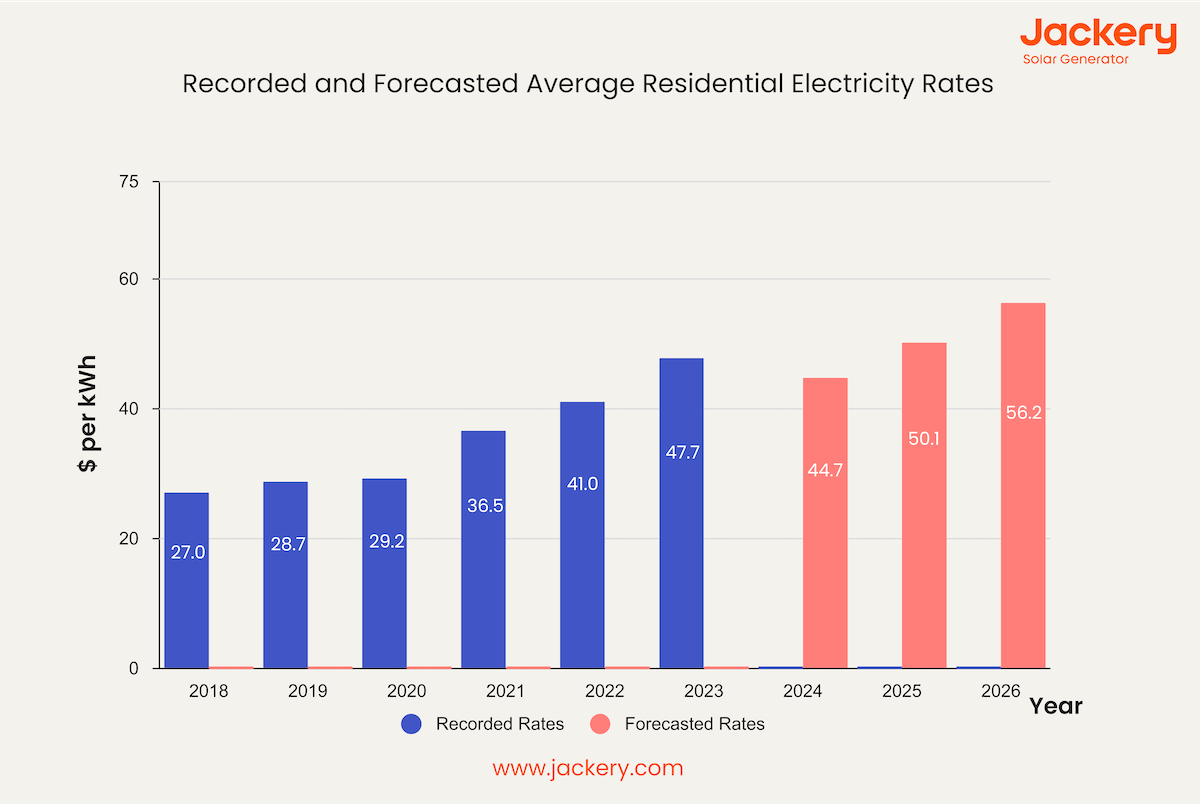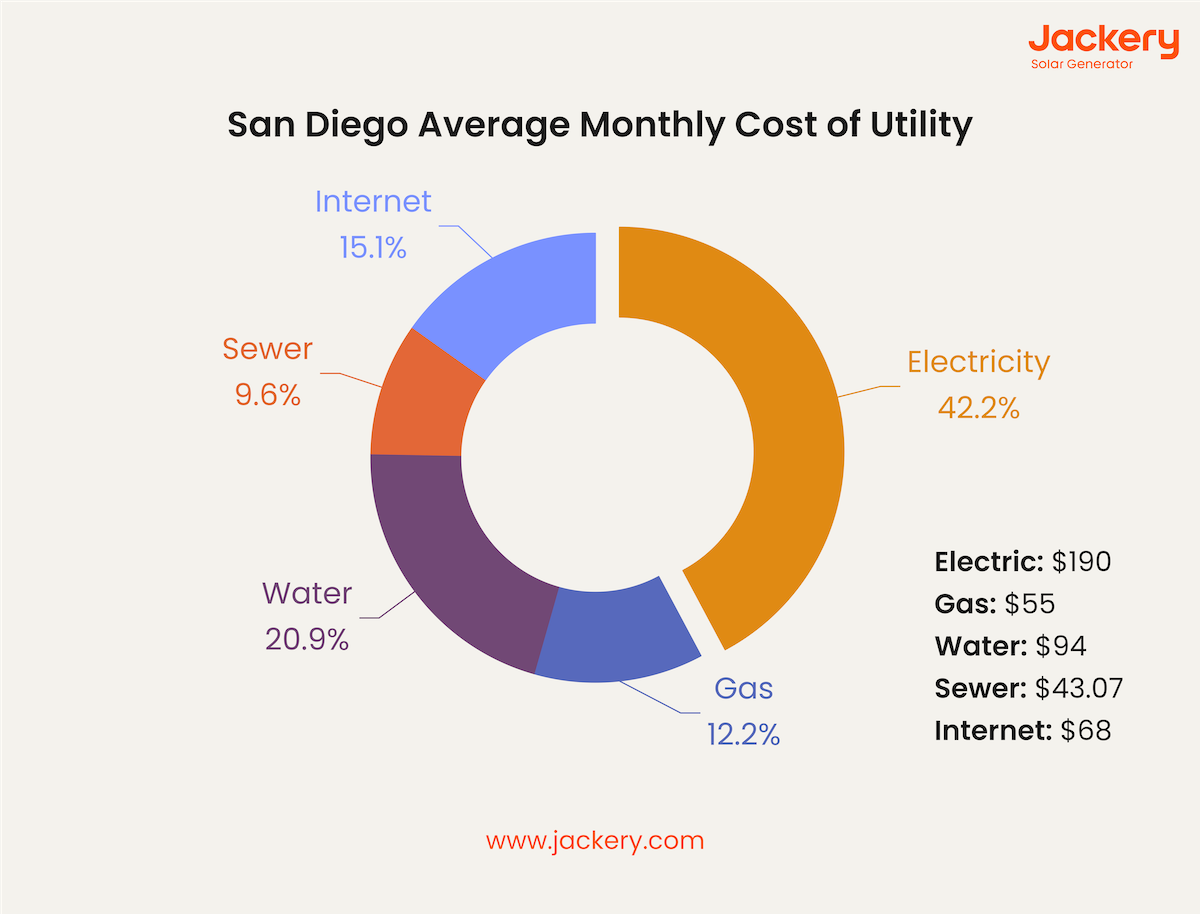Amongst major cities and states, the average electric bill in San Diego stands third in the list and is much higher than the state average. As of July 2024, it’s around $166.80 and expected to rise sharply in the coming years.
Worried? Don’t be, as the best way to wave it off is to spend on solar generators. Jackery Solar Generators is one of the best solar generators in terms of credibility, reliance, and efficiency. It’s portable, easy, and quick to charge, and the best models can power up heavy equipment like refrigerators, air conditioners, and others.
What Is The Average Electric Bill in San Diego?
No matter how you see it, San Diego residents are among the highest payers of electric bills in the nation. As of July 2024, the state’s average electric rate per kWh stands at 41.7 cents per kWh, and it continues to move in an upward trajectory. So, if an average user roughly uses 400 kWh a month, the average electric bill in San Diego is north of $166.80. That’s around 22% higher than the nation’s average of $147.70.
San Diego is a small coastal state with not a very high population, and the investor-owned utility, SDG&E, swaths its costs on them. Besides, energy consumption soars during extreme weather conditions. A study by the University of San Diego shows that people in coastal areas (like San Diego) typically consume 124% more electricity during summers (using ACs and refrigerators), which, going by the typical estimate, takes the electricity bill to $236. That’s the opposite during winters when most Californians use natural gas-powered heaters to combat the weather and there’s a spike in the price of natural gas.
Not only consumption but also price changes under time-of-use plans are typical reasons behind higher monthly bills. During on-peak hours, the rate per kWh stands at 65.87 cents in summer compared to 41.4 cents in winter. That reflects heavily on your monthly electric bills.
Have San Diego Electric Bills Changed These Years?
San Diego’s electric prices have been relatively high for many years, but the rise has been rapid since 2020. According to a US BLS (Bureau of Labor Statistics) report, the electric rate has risen from 27.9 cents per kWh in May 2020 to 47.7 cents in December 2023, around a 70% increase in just three years.
The chart below shows the average recorded rates from 2018 to 2023, as per BLS, alongside the forecasted rates by CPUC in their published Senate Bill 695 report.

Source: BLS and CPUC
While all forecasts are subject to change, it’s worth noting that the forecasts made in the Senate Bill report are lower than what BLS has recorded so far, probably due to their difference in data collection methods.
The Senate bill forecasts that SDG&E will probably charge 39% more from its customers in 2026, with an annual increase of 10.4%. If you go by the recorded rates by BLS, you can expect the rate to stand at 64 cents per kWh. That takes the average electric bill in San Diego to $320, considering the consumption stays the same.
Irrespective, the bottom line here is that SDG&E already charges the highest electric rates in the nation, and they will keep climbing. Now, let’s look into how the rates in San Diego compare to other states. Here’s a table of comparison:
|
City / State |
Avg. Monthly Electric Bill |
Avg. Electricity Price |
Avg. Monthly Usage |
|
San Diego |
$166.80 |
41.7 ¢ per kWh |
400 kWh |
|
Hawaii |
$227.32 |
44.14 ¢ per kWh |
515 kWh |
|
Texas |
$173.64 |
14.74 ¢ per kWh |
1178 kWh |
|
Illinois |
$120.31 |
16.71 ¢ per kWh |
720 kWh |
|
Colorado |
$102.00 |
14.74 ¢ per kWh |
692 kWh |
|
New York |
$139.71 |
23.60 ¢ per kWh |
592 kWh |
|
Alaska |
$145.12 |
25.02 ¢ per kWh |
580 kWh |
|
Florida |
$151.43 |
13.63 ¢ per kWh |
1111 kWh |
|
Michigan |
$126.75 |
19.44 ¢ per kWh |
652 kWh |
|
Oregon |
$142.18 |
15.03 ¢ per kWh |
946 kWh |
|
Arizona |
$164.46 |
15.50 ¢ per kWh |
1061 kWh |
Source: EIA
Despite the lowest consumption amongst the major states, residents in San Diego pay second most in electric bills. As per the report released by the US Bureau of Labor Statistics, the metropolitan area ranks third in this respect. For more than a year, it finished top in the monthly reports, while Hawaii managed to wrestle back to the top.
What Are The Electric Rates in San Diego?
Now, the first question here is, what is the average electric bill in San Diego? According to BLS, a customer, on average, pays $190 monthly and $2280 yearly on electric bills. The numbers vary from one utility provider to another.
In San Diego, the major investor-owned utilities are SDG&E, PG&E, and SCE, and their nominal rates are as follows:
|
Providers |
Nominal Rate (January 2024) |
|
Pacific Gas and Electric Company (PG&E) |
36.6 ¢ per kWh |
|
San Diego Gas & Electric (SDG&E) |
40.4 ¢ per kWh |
|
Southern California Edison (SCE) |
31.0 ¢ per kWh |
Note: These rates per kWh are subject to change, so make sure to check the official website of the utility provider for the latest information.
As mentioned earlier, the numbers peak with the time-of-use rate. But what is it? In simple words, it’s an energy metering plan that charges customers based on when they consume energy. These rates vary from provider to provider by time of day, season, and day of the week, so it’s imperative to check in with your utility provider regarding these.
For example, the SDG&E customers enrolled in a TOU rate structure have to pay 65.87 ¢ per kWh during on-peak hours in summers, while 41.4 ¢ per kWh during on-peak hours in winters. Similarly, PG&E charges are 62 ¢ per kWh and 47.3 ¢ per kWh for respective on-peak hours in summers and winters.
A TOU plan structure includes three tiers: on-peak, when energy consumption is at its peak; off-peak, when people use less energy; and super-off-peak when demand is the lowest. Here are the respective Time-of-use hours for SDG&E and PG&E.
For SDG&E
Weekdays
|
TOU-Period |
Summer |
Winter |
|
On-Peak |
4-9 pm (63.67 ¢ per kWh) |
4-9 pm (43.55 ¢ per kWh) |
|
Off-Peak |
6 am – 4 pm & 9 pm-midnight (41.34 ¢ per kWh) |
6 am – 4 pm & 9 pm-midnight (38.89 ¢ per kWh) |
|
Super Off-Peak |
Midnight – 6 am (33.78 ¢ per kWh) |
Midnight – 6 am (33.17 ¢ per kWh) |
Source: SDG&E
Weekends
|
TOU-Period |
Summer |
Winter |
|
On-Peak |
4-9 pm (63.67 ¢ per kWh) |
4-9 pm (43.55 ¢ per kWh) |
|
Off-Peak |
2 am – 4 pm & 9 pm-midnight (41.34 ¢ per kWh) |
2 am – 4 pm & 9 pm-midnight (38.89 ¢ per kWh) |
|
Super Off-Peak |
Midnight – 2 pm (33.78 ¢ per kWh) |
Midnight – 2 pm (33.17 ¢ per kWh) |
Source: SDG&E
For PG&E
PG&E has two TOU rate plans as of January 2024, known as TOU-C and TOU-D, with minute differences to note.
|
|
TOU-C |
TOU-D |
|
On-peak hours |
4-9 pm every day |
5-8 pm only on non-holiday weekends |
|
Peak Price (Summer) |
62 ¢ per kWh |
59 ¢ per kWh |
|
Off-peak Price (Summer) |
53 ¢ per kWh |
45 ¢ per kWh |
|
Lower Rates for Baseline Allowance? |
Yes |
No |
|
Summer Months |
June-September |
June-September |
|
Winter Months |
October-May |
October-May |
Source: PG&E
The basic premise of this structure is to avoid using heavy electric-consuming appliances during on-peak hours as much as possible. This especially applies to SDG&E territory that charges around 68 ¢ per kWh during peak hours in summer, taking your average bill to up to $272 per month. Compared to it, the average bill is around $165 during off-peak hours with the same usage. So, manage your electricity consumption smartly.
But before that, finding the best electric rate in San Diego is essential. First, explore the utility providers in your area and compare which offers the best price. You can just visit CPUC’s official website, enter your zip code and the type of electric rate you’re interested in (CARE, residential, or EV), and compare the rates for different providers available.
Why Is My Electric Bill So High in San Diego?
San Diego residents often wonder why their electric bill is so high. There are various underlying factors, be it your location, higher electricity costs compared to other states, plan structure, or old appliances you’re using. Let’s understand these in detail.
Old Appliances
Appliances made around a decade ago didn’t comply with Energy Star ratings like modern appliances. As a result, they hog around three to four times the electricity, which is why you empty your pockets every month. The solution is to upgrade your old appliances to modern ones with at least three to four Energy Star ratings.
Enrolled On a Time-of-use Structure
As mentioned earlier, most energy providers have a time-of-use payment structure that claims to save a chunk, but in most cases, users end up paying more. You should evaluate your monthly bill and the breakdown of costs, try using electricity-hogging appliances like dishwashers, air conditioners, and others during off-peak hours, and notice the change next month.
Extreme Temperature
San Diego is in an extremely sunny region, forcing residents to turn on their air conditioners for hours to stay comfortable and, in turn, pay higher energy bills. Furthermore, the metropolitan area is subject to temperatures below freezing to over 100 degrees Fahrenheit throughout the year, making climate control a serious necessity.
Higher Utility Rates
The electricity cost per kWh is one of the highest in San Diego compared to any metropolitan area due to various initiatives and mandates designed to move the state towards using renewable energy sources. These costs are passed onto the customers, who end up paying a chunk of their salaries on electric bills.
Measures like changing appliances and avoiding peak hours help in the short term and require altering your habits, but the best way out is going solar. Replacing electricity sources from grids with solar energy to power your home and appliances reduces electric bills and is especially helpful for those living in sunny areas of San Diego.
Jackery Solar Generators have batteries that can hold a lot of power to keep your appliances running for hours. These are portable, don’t require any heavy installation, and are suitable during power outages or living off-grid.
How Much Does It Cost to Live in San Diego?
While housing costs are more expensive in San Diego, residents can expect to pay around 3% more to enjoy basic resources such as water, electricity, internet, and gas. Let's explore in detail how much you have to pay for utilities.
Electricity
Electricity prices have sky-rocketed over the years, mainly due to the upgrades providers (SDG&E, PC&E, and others) made to meet the increasing demands, and the cost is passed onto the customers. The monthly average electric bill in San Diego has gone up by almost $78 from 2020 to 2023, which means you’ll pay around $936 on your yearly bills. That’s around 22% more than what an average US person pays.
Gas
As the weather gets chilly in San Diego, gas bills are something customers should be wary of. Last year, bills reached an all-time high due to many reasons. Primary one is people crank up their heaters as the weather gets colder. Besides, at the start of 2023, the wholesale price of natural gas soared to record levels by almost 450% across California. Some customers got double their bills in January and February, making them irate.
Water and Sewerage Costs
Water and sewerage costs are a pivotal part of any resident’s budget. After paying off the installation fee in the first monthly bill, new residents can expect to pay around $94 until mid-2023, which can rake up to $101 in early 2025.
Sewer rates are a bit higher than the national average, and as per the County of San Diego, you can add up to $43.07 to your bills next year.
Internet Bills
Internet bills vary from one provider to another and depend on the data speed you choose. Considering the major companies, the average bill is about $68 monthly.

Here's a table revealing the costs of different utilities in San Diego.
|
Utility |
Cost |
|
Electric |
$190 |
|
Gas |
$55 |
|
Water |
$94 |
|
Sewer |
$43.07 |
|
Internet |
$68 |
Note: The exact utility cost might vary depending on the monthly usage.
If you want to lower your monthly electricity bills in San Diego, here are a few tips to follow:
- Switch off the lights and fans when you are not in the room.
- Invest in a smart and programmable thermostat to adjust the temperature of the AC and save electricity.
- Turn off the electrical appliances when you are not using them.
- Consider charging household appliances with the help of Jackery Solar Generators that work using free solar energy.
Jackery Solar Generators for Lowering Your Electric Bills
Jackery is among the top manufacturers and sellers of solar generators, power stations, and solar panels. A Jackery Solar Generator combines Jackery Explorer Portable Power Stations and foldable Jackery SolarSaga Solar Panels to keep your air conditioners and other appliances running without draining your wallet.
So how does it work? Its monocrystalline silicon cells inside Jackery SolarSaga Solar Panels take up sun rays and convert them into DC, which passes onto a pure sine wave inverter of the Jackery Explorer Portable Power Stations to further convert into AC current. It then moves on to powering most of your household appliances.
Jackery Solar Generator 3000 Pro
Jackery Solar Generator 3000 Pro is probably one of the best for home backup. Its 3024 Wh NMC battery can power up to 99% of your home and outdoor appliances, including air conditioners and space heaters. You can plug it into the wall charger, charge it with a car battery, or power it with the 6*Jackery SolarSaga 200W Solar Panels.

|
|
Solar Generator 3000 Pro |
|
Capacity |
3024 Wh |
|
Battery Cell |
NMC |
|
Cycle Life |
2000 cycles to 70%+ capacity |
|
Recharging Methods |
Solar Recharging: 3.5 H (6*Jackery SolarSaga 200W Solar Panels) Car Recharging: 35 H Wall Recharging: 2.4 H |
|
Output Ports |
AC Output (x1): 120 V~ 60 Hz 25 A Max AC Output (x3): 120 V~ 60 Hz 20 A Maximum USB-C Output (x2): 100 W Maximum, 5 V⎓3 A, 9 V⎓3 A, 12 V⎓3 A, 15 V⎓3 A, 20 V⎓5 A |
|
Working Hours |
Toaster Oven (1250 W): 2.05 H Ceiling Fan (150 W): 17.1 H Clothes Iron (1800 W): 1.4 H Portable Heater (1000 W): 2.6 H Microwave (1000 W): 2.6 H |
|
Customer Review |
“It worked really good; it worked all night. Long on a heater to keep the cold out when the electricity went out.” — Alicia. |
Jackery Solar Generator 2000 Plus
Jackery Solar Generator 2000 Plus boasts an exceptional LiFePO4 battery, which has a capacity of 2042.8 Wh The whole-home battery-powered generator can charge 99% of household appliin San Diego. With the addition of the Jackery Battery Pack 2000 Plus, you can expand the battery capacity from 2 kWh to 24 kWh to enjoy complete off-grid living.

|
|
Solar Generator 2000 Plus |
|
Capacity |
2-24 kWh |
|
Battery Cell |
LiFePO4 |
|
Cycle Life |
4000 cycles to 70%+ capacity |
|
Recharging Methods |
Solar Recharging: 2 H (6*Jackery SolarSaga 200W Solar Panels) Car Recharging: 25 H Wall Recharging: 2 H |
|
Output Ports |
AC Output (×4) 120 V~ 60 Hz, 20 A Maximum AC Output (×1) 120 V~ 60 Hz, 25 A Maximum USB-A Output (x2): Quick Charge 3.0, 18 W Maximum USB-C Output (x2): 100 W Maximum, (5 V, 9 V, 12 V, 15 V, 20 V up to 5 A) |
|
Working Hours |
Coffee Maker (1100 W): 1.5 H Ceiling Fan (150 W): 11.6 H Clothes Iron (1800 W): 1 H Water Pump (1125 W): 1.5 H Microwave (1000 W): 1.7 H |
|
Customer Review |
“Excellent quality, the battery lasts a very long time. It is straightforward to move around with the built-in tires. I love the upgradeability. Best solar generator I have ever had.” — Marc. |
San Diego Average Electric Bill FAQs
What size of solar generator do I need for my house in San Diego?
The size of the solar generator needed depends on the size of your house, the number of appliances, and the hours they are running.
Let’s consider you’re running a sump pump (800 W), a TV (150 W), and a mini refrigerator (400 W) simultaneously using Jackery Solar Generator 3000 Pro. The number of hours the generator powers them can be calculated using the formula:
Working Time = Battery Capacity * 0.85 / Operating Wattage of Appliances = 3024 Wh * 0.85/ 1350 W = 1.9 H
How much is the average electric bill in San Diego?
The average electric bill in San Diego, as per EIA, is around $190 per month and $2280 per year.
What is the average monthly bill for Sdge?
As of January 2024, the average monthly bill for SDGE users (without the TOU plan structure) is $161.6.
Why is San Diego's electricity so expensive?
Electricity in San Diego is the most expensive due to upgrades made on grids passed onto the bills, renewable energy mandates, TOU rates, and extreme temperatures.
What city has the highest electric bill?
According to Doxo, San Diego has the most expensive electricity in the continental US.
Final Thoughts
Electric bills, especially in San Diego, have escalated in the last few years and are expected to go even higher. The primary reason is to foster the adoption of solar energy, and it’s high time you dive into the adoption wave. And what’s better than investing in a solar generator?
Despite many available in the space, Jackery Solar Generators are a popular choice. Their powerful battery can charge up to 99% of your appliances, saving you more on average electric bills in San Diego in the long run. You can charge the complimentary Jackery SolarSaga Solar Panels even on the go or during a power outage.












































































































![What Is The Average Electric Bill in San Diego [2024]](http://www.jackery.com/cdn/shop/articles/average_electric_bill_in_san_diego_by_jackery.jpg?v=1713341607)







Leave a comment